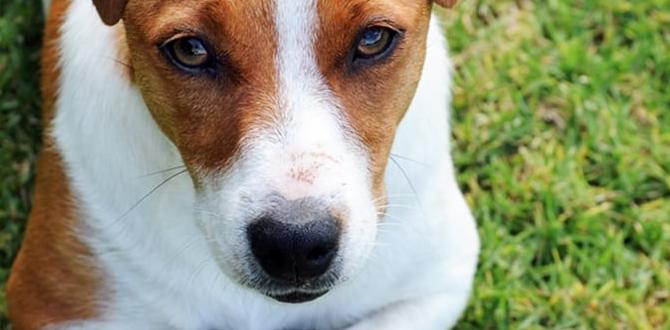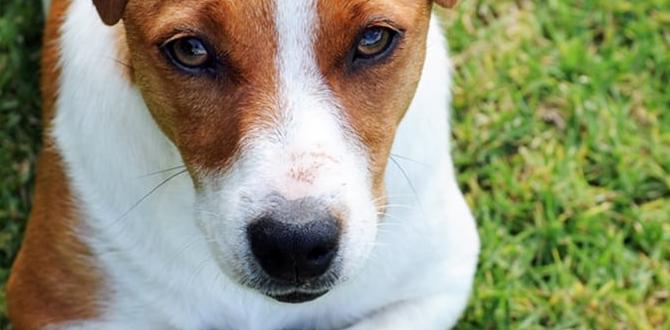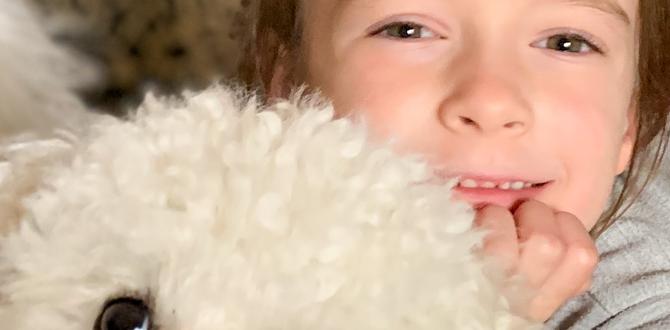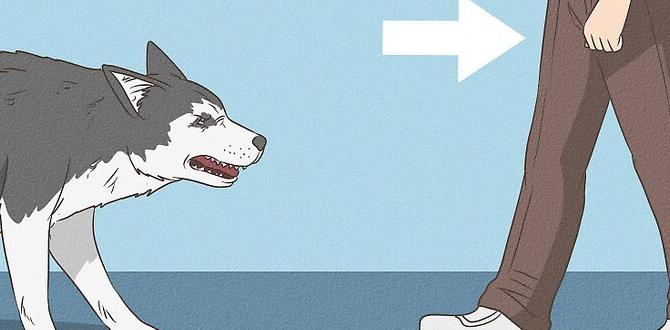Many dog owners have experienced a moment like this: the doorbell rings, and their furry friend starts to shake. If you have a dog scared of visitors, you know how worrying this can be. What could be causing this fear? Is it the loud noises, new faces, or something else altogether?
Dogs, like people, have their own personalities and feelings. Some dogs love meeting new friends, while others hide behind the couch. It might surprise you to learn that a dog’s fear of visitors is quite common. In fact, understanding this behavior might help you and your pup feel more comfortable when friends come over.
So, what can you do to help your dog feel at ease? This article will explore the reasons behind a dog scared of visitors and share tips to make visits fun for everyone. Let’s dive in and discover how to turn that fear into joy!
Dog Scared Of Visitors: Understanding Their Behavior And Solutions

Dog Scared of Visitors
Is your furry friend anxious when guests arrive? Dogs often feel scared of visitors due to their protective nature or lack of socialization. Understanding dog body language helps you see signs of fear, like hiding or barking. To help your pet, create a safe space and introduce visitors slowly. Using treats can make guests seem less scary. Did you know that many dogs are more afraid of loud noises than of visitors? With some patience and care, you can turn your dog into a more confident companion!Common Signs of a Dog Scared of Visitors
Vocalizations and barking at new people. Hiding or retreating to a safe space.Dogs communicate their fear in different ways. One sign is loud vocalizations. They may bark at new people to show they feel scared. Another sign is hiding. If a dog retreats to a safe spot, it means they’re not comfortable with visitors. These behaviors can help you understand your dog’s feelings.
What should you do if your dog is scared of visitors?
If your dog hides or barks, try giving them space. Let them get used to visitors slowly. You can also use treats to help your dog feel more comfortable.
Understanding the Causes of Fear in Dogs
Genetic predispositions and breed tendencies. Lack of socialization during critical development stages.Some dogs are born with personalities that make them more fearful. This is called genetic predisposition. Certain breeds, like Chihuahuas, can also be more timid. Another reason for fear is lack of socialization. Puppies need to meet various people and pets during their first few months. Missing this chance can lead to lifelong anxiety around visitors. Understanding these reasons can help owners support their scared dogs.
What can I do to help my scared dog?
You can help your dog by slowly introducing them to visitors and rewarding good behavior. Make the meeting fun with treats to create positive feelings about new people.
Other tips include:
- Practice calm greetings
- Use positive reinforcement
- Keep a routine
Behavioral Techniques to Help Your Dog
Gradual desensitization to visitors. Positive reinforcement for calm behavior.If your dog gets spooked by visitors, there are fun ways to help! Start with gradual desensitization. This means slowly introducing your dog to new people. Let them sniff and wag their tail from a distance. Remember, Rome wasn’t built in a day; neither is a fearless pup! Next, use positive reinforcement. Reward calm behavior with treats or belly rubs. Who can resist those puppy eyes? Even a timid dog can become a social butterfly with a little time and patience.
Creating a Safe Space for Your Dog
Designing a comfort zone during visits. Utilizing barriers or gates to minimize stress.Making a special spot for your dog can help them feel safe. This area should be quiet and comfy, away from visitors. You can use pillows, blankets, and toys to make it cozy. Barriers or gates can also help keep your dog calm during visits. They create a space the dog can retreat to when feeling scared. Try these tips:
- Choose a quiet room.
- Add comfortable bedding.
- Use gates to block off areas.
- Keep the area free from distractions.
This way, your dog can feel secure even with new people around.
How can I help my scared dog during visits?
Start by giving them a safe space. This zone should be quiet and filled with their favorite toys. Let your dog go there when guests arrive. This helps them feel safe and reduces their fear.
Training Tips to Build Confidence
Basic obedience training as a foundation. Introducing controlled socialization experiences.Teaching a dog basic commands can boost their confidence. Start with simple commands like sit, stay, and come. It’s like giving your dog a superhero cape. They feel strong and ready to face anything. Once they master these, set up controlled playdates. Invite a calm friend over and let your pup meet them slowly. Use treats to reward good behavior. Remember, patience is key. Just like we need practice, so do our furry friends!
| Training Step | Purpose |
|---|---|
| Basic Commands | Build confidence |
| Controlled Playdates | Encourage social behavior |
Proactive Measures to Reduce Anxiety
Establishing a routine for visitor interactions. Using calming products and techniques.Creating a friendly routine before visitors arrive can help your dog feel safe. Start by letting your furry friend sniff the visitor’s shoes. It’s like their version of a secret handshake! Next, try calming products, like lavender sprays or soft music. Think of it as a spa day, but for your pup. You can even prepare a cozy spot with blankets for them to retreat when things get a bit too noisy. Check out the table below for a fun look at techniques you can try!
| Technique | Description |
|---|---|
| Routine Sniffing | Let your dog sniff visitors to ease tension. |
| Calming Products | Use sprays or music to soothe nerves. |
| Cozy Retreat | Create a safe space with blankets. |
When to Seek Professional Help
Identifying signs that require a behaviorist. Understanding the role of veterinary advice in severe cases.Some signs show that your dog may need a professional. If your dog barks, hides, or growls at visitors often, it’s a red flag. Behaviorists can help understand and fix these fears. Sometimes, dogs may act fearful due to a health issue. In those cases, getting advice from a vet is crucial. A vet can check for physical problems and suggest what to do next. Early help can lead to better behavior.
When should I call a behaviorist for my dog?
Look for these signs:
- Constant barking at visitors
- Hiding or refusing to come out
- Showing aggressive behavior
- Extreme anxiety when people arrive
What can a vet do for a scared dog?
A vet can check for any health issues that cause fear. They may find underlying problems that behaviorists can’t address. A vet’s advice is key for your dog’s well-being.
Conclusion
In conclusion, if your dog is scared of visitors, you’re not alone. Many dogs feel anxious around new people. You can help your pup by slowly introducing them to guests. Create a safe space for your dog and use positive reinforcement. If problems persist, consider seeking advice from a dog trainer. Together, we can make visits fun and stress-free for everyone!FAQs
What Are Some Common Reasons Why Dogs Might Be Scared Of Visitors?Dogs might be scared of visitors for different reasons. First, they may not know the person and feel unsure. Loud noises, like ringing doorbells, can also frighten them. Some dogs have had bad experiences before, making them more nervous. Finally, if a dog is shy or anxious, it may be scared of new people.
How Can I Help My Dog Feel More Comfortable Around New People?To help your dog feel more comfortable around new people, start slowly. You can keep your dog on a leash and let them sniff the new person from a safe distance. Encourage the new person to give your dog some treats. This helps your dog make a happy connection. Always watch your dog’s body language to see if they are feeling safe.
What Techniques Can I Use To Gradual Acclimate My Dog To Meeting Visitors?To help your dog get used to visitors, start by letting them sniff the visitor’s things first. Then, have the visitor toss your dog a treat from a distance. Slowly let them get closer while giving treats each time. Encourage your visitor to stay calm and avoid sudden movements. Praise your dog for being calm so they learn that visitors are fun!
Are There Specific Training Methods Or Tools That Can Assist In Reducing My Dog’S Fear Of Strangers?Yes, there are tools and methods to help your dog feel better around strangers. You can use treats to reward your dog when they stay calm. Make sure you introduce them to new people slowly. You can also play fun games with your dog to build their confidence. Consistency and patience will help your dog learn to trust strangers.
How Can I Recognize Signs Of Anxiety In My Dog When Visitors Arrive, And What Should I Do If They Become Overly Stressed?You can recognize signs of anxiety in your dog when visitors come by watching how they act. Your dog might hide, shake, or bark a lot. They may also lick their lips or try to run away. If your dog gets too stressed, take them to a quiet room. Give them a toy or some treats to help them relax.
Meet Elyse Colburn, the devoted canine companion and storyteller behind the enchanting world of “Tales, Tails, and Adventures Unleashed.” A passionate dog enthusiast with a heart full of paw prints, Elyse Colburn shares heartwarming tales and insightful adventures, celebrating the joy, loyalty, and endless antics that make every dog a true hero. Join Elyse Colburn on this tail-wagging journey, where every post is a love letter to our four-legged friends.








